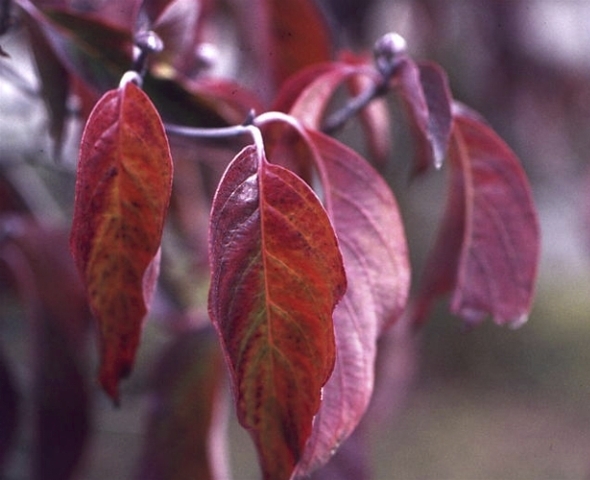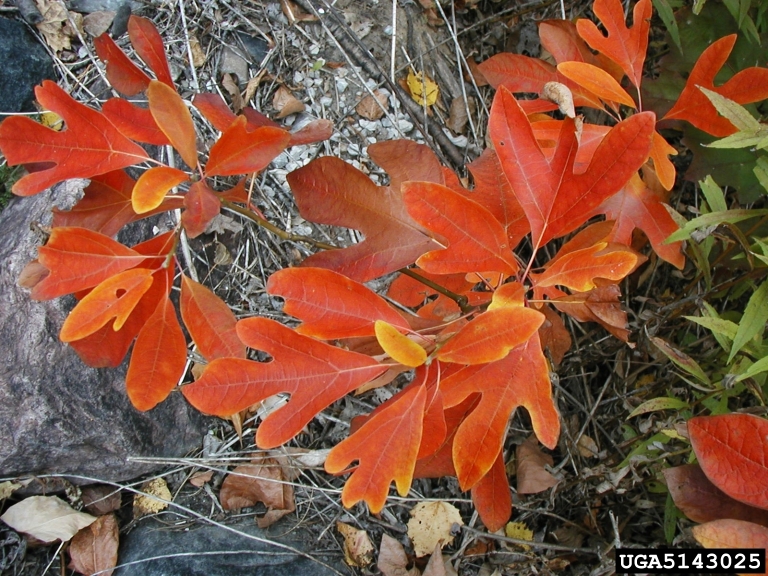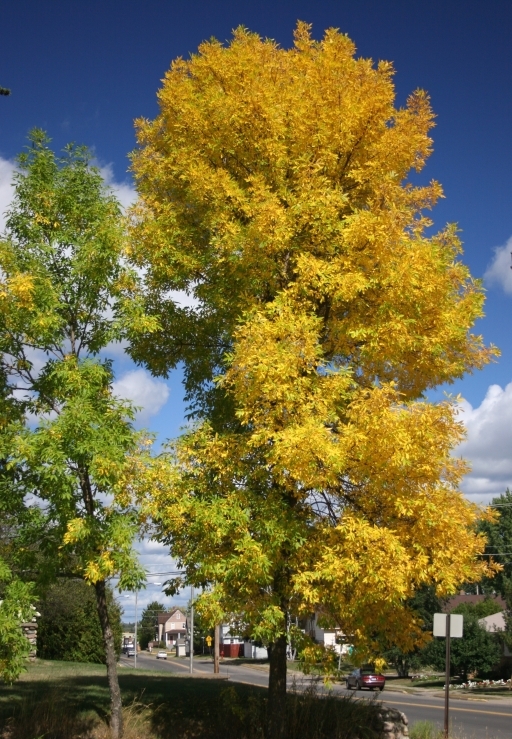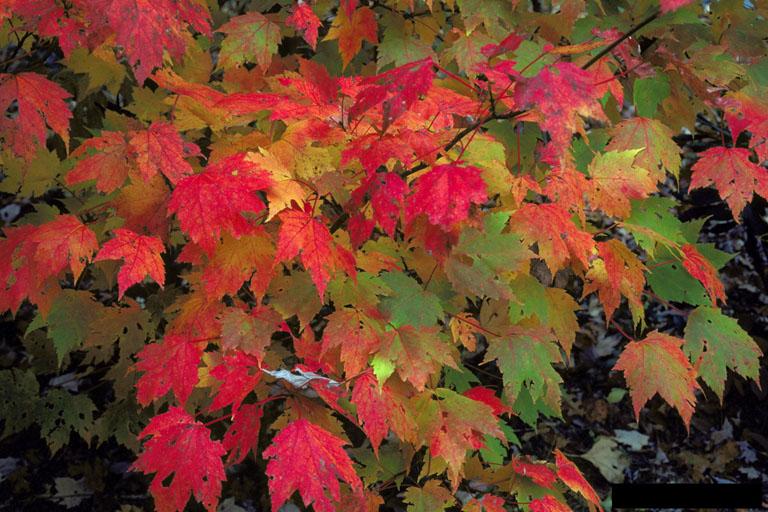by Jim McGlone, Urban Forest Conservationist, Virginia Department of Forestry
 One of the great pleasures of living in the Eastern United States is the fall color display of our deciduous forests. While this autumnal display is beautiful to the eye, it is also a beautiful interplay of biology, chemistry and physics; and that interplay starts well before the fall.
One of the great pleasures of living in the Eastern United States is the fall color display of our deciduous forests. While this autumnal display is beautiful to the eye, it is also a beautiful interplay of biology, chemistry and physics; and that interplay starts well before the fall.
In order to understand colors, it is important to have some understanding of light. Although not scientifically precise, light can be thought of as particles called photons that vibrate as they travel through space. The vibration causes the path of the photon to look like a wave with rounded peaks and troughs. Although any photon will take the same time to move from one point to another, the more energetic photons vibrate more and have more peaks over that space and therefore shorter wavelengths (the distance between peaks) than less energetic photons.
Wavelengths can be from a few microns to many meters, but the human eye can only detect a small band of wavelengths called visible light. The mnemonic ROY G BIV can help recall the colors of visible light – red, orange, yellow, green, blue, indigo, and violet – in the order of least energetic to most energetic photons. Trees are green in the summer because they absorb all the ROBIV and most of the Y photons that fall on them and reflect the rest of the Y and all the G photons. As leaves change color in the fall they begin reflecting more of the ROY photons. But why?
Let’s look at the biology of deciduous trees. Deciduous trees, like all green plants, have evolved the ability to capture solar energy and convert it to bio-chemical energy through the process of photosynthesis. Unlike evergreen trees and some other plants, deciduous trees have evolved the strategy of dealing with the cold temperature and low light of winter by going dormant and losing their delicate leaves. Before leaves fall they undergo a process of senescence where sugars, starches, nutrients and other valuable compounds are sent back into the tree for winter storage and re-use in the spring. So the biological processes of photosynthesis and senescence account for most of the colors of trees.
Trees are green in the summer because chlorophyll, the most abundant pigment in leaves, absorbs ROY and BIV photos and uses their energy to make sugars during photosynthesis. There are actually two types of chlorophyll – a and b. Chlorophyll a, or sun, uses RO and IV light and chlorophyll b, or shade, uses OY and BI light. All green plants have both, but, as their names suggest, the shade tolerance of a plants is determined by the proportion of each. Since sun chlorophyll reflects more B and Y, sun loving plants usually have lighter green leaves than shade tolerant plants.
 Several things happen in the fall to create the color changes we see, and much of it has to do with chlorophyll. Chlorophyll is a delicate molecule and is easily damaged BIV light, so leaves contain carotenoids. Carotenoids, which consist of xanthophylls and carotenes, are tough molecules that strongly absorb BIV light and protect chlorophyll. Some of the absorbed energy is used in photosynthesis, but most is dissipated as heat.
Several things happen in the fall to create the color changes we see, and much of it has to do with chlorophyll. Chlorophyll is a delicate molecule and is easily damaged BIV light, so leaves contain carotenoids. Carotenoids, which consist of xanthophylls and carotenes, are tough molecules that strongly absorb BIV light and protect chlorophyll. Some of the absorbed energy is used in photosynthesis, but most is dissipated as heat.
Carotenoids are also anti-oxidants. The cooler nights and shorter days of fall signal the leaves it is time for senescence, so they begin to produce enzymes that help dismantle chlorophyll and send the pieces back into the tree. But chopping up chlorophyll produces free radicals, so the leaves also produce more carotenoids to protect the leaf tissues from the radicals. As the leaves lose chlorophyll, the colors of the carotenoids start to come through – xanthophyll yellow and carotene orange.
Fall leaves also produce anthocynins, which are red to purple in color. Anthocynins do not contribute energy to photosynthesis, but are antioxidants and do provide protection from energetic BIV and ultra-violet photons. Anthocynins tend to be created as a stress reaction and contain sugars. Therefore, they are more likely to be present in larger quantities in outer canopy leaves and species that produce more sugars, like maples and sweetgums. Also cooler nights and sunny days provide the stress and energy to increase production of anthrocynins and carotenoids that makes a brighter display of color.
In addition to the colors that we can see, trees and other plants produce compounds that are visible in the near ultra-violet part of the spectrum, which most insects can see. Some of these UV colors are important in guiding pollinators to flowers, but many are toxic compounds whose UV signals warn insect grazers to stay away. Fertilizing trees in late spring or summer can induce a new flush of leaves when insect pest populations are at their height. These new, unprotected leaves look different, and tasty, to insect grazers that can see UV light and can lead to an attack that overwhelms the tree’s defenses. Stressed trees also produce fewer protective chemicals and their UV signals tell insects the trees are unprotected and ripe for eating.
The color of trees is an important indicator of health. All of the pigments mentioned here require energy and resources to create and maintain. When trees are stressed or unhealthy it affects the maintenance and creation of these compounds and causes trees to be off color or dull. To the trained human eye it means the tree needs some help; to the trained insect eye it means dinner is served.
Next time you stop to admire a particularly striking tree this fall, step back and remember all that went into producing those leaf colors. The energy it took to grow the leaf was fueled by photosynthesis, during which sun or shade chlorophyll absorbed non-green wavelengths of light. Cooler temperatures signalled to the tree that it was time to start senescence, breaking down green chlorophyll and pulling it back into the tree together with other nutrients for the winter. As the useful molecules were beating a hasty retreat, the leaf produced brilliant yellow and orange carotenoids and sugary red-purple anthocynins to protect itself from dangerous high-energy blue, indigo, and violet light. All the while, the tree was producing ultraviolet-colored compounds to repel harmful insects outside of our visible spectrum. From the physics of light to biological processes, there is more than meets the eye in the silent, calm majesty of a tree in its brilliant fall colors.
| Color | Source | Notes |
|---|---|---|
| Light Green | Chlorophyll a | Chlorophyll a absorbs and uses deeper colors like red, orange, indigo, and violet and reflects lighter colors yellow, green and blue. Sun-loving plants have more chlorophyll a, and thus lighter green leaves. |
| Dark Green | Chlorophyll b | Chlorophyll b absorbs lighter colors like orange, yellow, blue and indigo, and reflects darker colors red, violet, and green. Shade-loving plants have more chlorophyll b, and thus darker green leaves. |
| Yellow Orange |
Xanthophyll Carotene |
Carotenoids xanthophyll and carotene protect the leaf tissue from free radicals in the fall. During photosynthesis, they protect the chlorophyll molecule from harmful BIV light and contribute the absorbed energy to the process. |
| Red-Purple | Anthocynins | Anthocynins are antioxidants that protect the tree from high-energy BIV and UV rays. Anthocynins are often present in sugar-rich species like maples. |
| Ultraviolet | Other compounds | Ultraviolet compounds develop in healthy leaves over time. These compounds are often toxic to insects, causing them to steer clear of the tree. |
Where Do Leaf Colors Come From?

